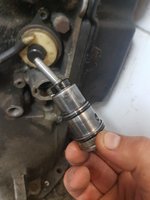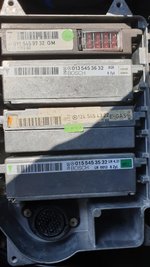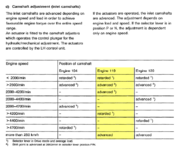Hello everyone, my name is Sam, a 25yo engineering student from Belgium. I just bought a 151 000 km (or about 100 000 mile) euro w124 400e from 1992 and I absolutely love it. It is packed with all thinkable options (including ASR) and drives/shifts like a dream. I have one problem though for which I haven't found a solution yet despite searching and trying all kind of fixes.
Basically, the car starts and runs fine (starts after about 2 seconds of cranking), but between 4000 and 6000 rpm there is a very aggressive jerking which really throws me out of my seat. This doesn't happen all the time, lets say about 80% of the time when I rev it to that rpm range. This happens in all gears, with or without kickdown. Also, there is a very noticable 'light' power loss at about 4250 rpm, even with WOT, it's like you back off of the gas a bit. This happens regardless of wether the car does the jerking thing or not. Besides all that, the engine also shake a bit too much in idle in my opinion.
The following things have been done to the car by myself in the past two months:
- Engine oil, oil filter and air filters
- tranny oil and filter change (including oil in torque converter)
- installed new bushings on shift rod (old ones were non existant)
- checked working of NSS: car does not start in any other gear except P or N, so NSS is doing it's job?
- new fuel filter (old one was from 1995 lol) (all filters from MANN)
- oil pan was dented, replaced with new one and changed the oil pump pickup with the newer, wider model as well)
- replaced oil level sensor too while bottom end was open
- fuel pump relay replaced (green one)
- new plugs (f8dc4), coils, leads, caps and rotors (all bosch with beru leads)
- new intake air temp sensor
- maf has been taken out and cleaned with maf cleaner (car still does the jerking, even with maf disconnected too, rubber grommet between eta and maf was in good condition)
- all vacuum connections in engine bay have been replaced
- ETA cleaned and tested, works fine, very responsive
- wiring looms (upper, lower and eta) been checked: all original, but all insulation looks like new and is very flexible, no deterioration whatsoever
- all fuses replaced with new ones (including the four 10A ones on the GM module)
- exhaust disconnected right infront of cats and driven, still does the jerking so cats are not clogged
- capacitors inside LH-module checked, none have leaked
- ezl reacts to vacuum, engine also fires on all 8 pots so I think ezl is fine too
- fuel pressure checked, I remember it should be 3.6 or 3.5 bars, mine jumped straight to 4 bars upon fuel pumps turning on
- liqui moly injector cleaner added to fuel, made engine run much better
- ASR disabled by jumping the pins on the diagnostic socket (I think pin 4 and ground), still does the jerking (very fun to drive though haha)
- rev limiter kicks in at around +-5250 rpm in P and N, same as my friends 400E, a 500E I have driven and a 500SEL, so I think that's working like it should
As you can see I have done a number of things which were suggested on this board and on the entire internet in general. I would also like to add that the ASR light never lights up. It just starts jerking like mad and when I back off the throttle it shifts up and acts normal. The point at which it jerks is not fixed, it happens between 4000 and 6000 rpm. Like I said, sometimes it doesn't jerk at all, yet I always feel a subtle power loss at about 4250rpm.
I still plan on changing the camshaft magnets, the insulator cups behind the rotors and also the pins of the diagnostic socket hence those can corrode and short out. It would be surprising if any of that helps, but I already have the parts so why not. Personally I lean more towards bad fuel pumps, causing pressure drops in the system, because after all, I tested the fuel pressure at idle without driving the car. Fuel pumps are quite expensive though (100 euro's a piece), and hence I'm still a student, I don't want to invest in those if they don't end up being the culprit...
It's getting kinda frustrating because every time I think i have found the solution, it turns out to be a dead end. That's why I wanted to ask you guys for help, hoping to find a solution together so that I could enjoy this amazing car for the remainder of the summer before it gets cold and rainy again.
Thanks in advance!
Sam
Basically, the car starts and runs fine (starts after about 2 seconds of cranking), but between 4000 and 6000 rpm there is a very aggressive jerking which really throws me out of my seat. This doesn't happen all the time, lets say about 80% of the time when I rev it to that rpm range. This happens in all gears, with or without kickdown. Also, there is a very noticable 'light' power loss at about 4250 rpm, even with WOT, it's like you back off of the gas a bit. This happens regardless of wether the car does the jerking thing or not. Besides all that, the engine also shake a bit too much in idle in my opinion.
The following things have been done to the car by myself in the past two months:
- Engine oil, oil filter and air filters
- tranny oil and filter change (including oil in torque converter)
- installed new bushings on shift rod (old ones were non existant)
- checked working of NSS: car does not start in any other gear except P or N, so NSS is doing it's job?
- new fuel filter (old one was from 1995 lol) (all filters from MANN)
- oil pan was dented, replaced with new one and changed the oil pump pickup with the newer, wider model as well)
- replaced oil level sensor too while bottom end was open
- fuel pump relay replaced (green one)
- new plugs (f8dc4), coils, leads, caps and rotors (all bosch with beru leads)
- new intake air temp sensor
- maf has been taken out and cleaned with maf cleaner (car still does the jerking, even with maf disconnected too, rubber grommet between eta and maf was in good condition)
- all vacuum connections in engine bay have been replaced
- ETA cleaned and tested, works fine, very responsive
- wiring looms (upper, lower and eta) been checked: all original, but all insulation looks like new and is very flexible, no deterioration whatsoever
- all fuses replaced with new ones (including the four 10A ones on the GM module)
- exhaust disconnected right infront of cats and driven, still does the jerking so cats are not clogged
- capacitors inside LH-module checked, none have leaked
- ezl reacts to vacuum, engine also fires on all 8 pots so I think ezl is fine too
- fuel pressure checked, I remember it should be 3.6 or 3.5 bars, mine jumped straight to 4 bars upon fuel pumps turning on
- liqui moly injector cleaner added to fuel, made engine run much better
- ASR disabled by jumping the pins on the diagnostic socket (I think pin 4 and ground), still does the jerking (very fun to drive though haha)
- rev limiter kicks in at around +-5250 rpm in P and N, same as my friends 400E, a 500E I have driven and a 500SEL, so I think that's working like it should
As you can see I have done a number of things which were suggested on this board and on the entire internet in general. I would also like to add that the ASR light never lights up. It just starts jerking like mad and when I back off the throttle it shifts up and acts normal. The point at which it jerks is not fixed, it happens between 4000 and 6000 rpm. Like I said, sometimes it doesn't jerk at all, yet I always feel a subtle power loss at about 4250rpm.
I still plan on changing the camshaft magnets, the insulator cups behind the rotors and also the pins of the diagnostic socket hence those can corrode and short out. It would be surprising if any of that helps, but I already have the parts so why not. Personally I lean more towards bad fuel pumps, causing pressure drops in the system, because after all, I tested the fuel pressure at idle without driving the car. Fuel pumps are quite expensive though (100 euro's a piece), and hence I'm still a student, I don't want to invest in those if they don't end up being the culprit...
It's getting kinda frustrating because every time I think i have found the solution, it turns out to be a dead end. That's why I wanted to ask you guys for help, hoping to find a solution together so that I could enjoy this amazing car for the remainder of the summer before it gets cold and rainy again.
Thanks in advance!
Sam
Last edited:



















